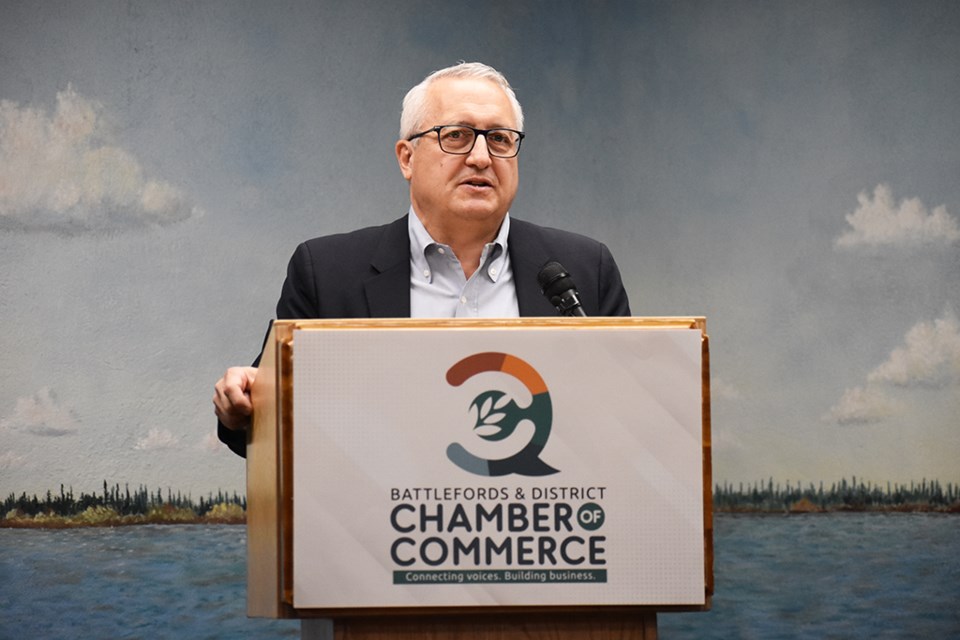THE BATTLEFORDS — One of the memories that stick with former CEO of the First Nations Bank of Canada, Keith Martell, is the ham and cheese sandwiches at North Battleford's bus depot when he was a kid.
"Every time I drive down Railway Avenue, I taste one of those white bread, ham and cheese sandwiches," he told the business community during his guest speech at the Chamber of Commerce's 118th Chair Luncheon on Jan. 30.
But besides the trips via bus to visit family in Meadow Lake, he said he also spent a few months working in North Battleford during the week.
"I drove up here every Monday morning, and I drove back to Saskatoon every Friday evening and at that time, that highway wasn't divided. So I was fighting late traffic both ways coming and going," he said, laughing.
"And I've got a real sense of how important that lake environment is to this community, having all those dollars and people come into the community every weekend was so important, not only to the economy but the culture of the city."
But what he really wanted to talk about, was how the business community can help the Battlefords thrive despite the challenges it faces.
He said that businesses have to ensure that beyond working in their community they have to push products and services out to the rest of Saskatchewan and Canada or else risk stagnating, or experiencing, 'economic leakage.'
"If you don't bring outside dollars into your community, you're really just transferring around the same dollars within the community," Martell said. though the Battlefords does that in the summer when people bring their dollars through town on the way to the lake.
Challenges: understand them and their limits
But there are challenges to pushing out services to the rest of the province and country. The first. Martell noted, is the small population size.
Martell explained that a 30-square-block in Downtown Toronto has a population of 26,000, nearly identical to the entire population of the Battlefords. Within a 100-kilometre radius around the Battlefords, the population grows to 62,000. In Toronto, that would be 10.4 million.
He said the Battlefords just don't have the economic power they need that comes from within.
"And if you do that, you may stay around 20,000, you may stay fine. But I think it's going to over time bleed to opportunity from your region. And it's going to make it more difficult to run businesses in a community."
The other issue he noted is the lack of services. On a practical level, a business has fewer chartered accountants, lawyers, tech people, website developers, and more, to help a business grow. One of his own pet peeves is the cost and time of travel out of Saskatoon or Regina, compared to Toronto or Vancouver.
"So those are all costs of doing business and we can overcome some of that stuff. But some of it's just going to make it more difficult. So what does that mean for running businesses from your community?"
Martell says business owners have to understand the limits.
"You have to understand that mass market, low margin businesses don't make sense in this kind of environment. You have to find specialized services and products with enough margin to overcome all those costs of doing business," he said.
"And that's something that we just have to get over ... we have to move beyond just simply shipping raw materials."
How can the Battlefords be a hub of economic activity?
Martell says beyond understanding the limitations, as well as boons like having wide open spaces and natural resources, the population of the community likely has to increase to avoid stagnation.
Organically, the population grows by keeping people in the Battlefords by creating local opportunities and showing people there is room for growth if they stay. Inorganically, people have to be attracted to move here.
"And more and more attracting people to move to your region means they are people that don't look or act like you. They may have different food habits, they may have different religious backgrounds, they may have different cultures that you need to deal with."
But beyond that, Martell says even if business offers the best job in the world, opportunities have to be offered for the rest of the family.
"In the old days, you could probably get, normally a guy, to just drag his family out to an opportunity anywhere in the world. They move to mining communities all over the north ... and they just drag their families along and their families had nothing to do but that was the reality. That's not the reality anymore."
He says a community has to offer opportunities for spouses, for children via competitive sports programs, and activities that compete with the ones in Toronto.
The power of a local Chamber of Commerce
"And what can governments do to help you do this?"
Martell noted that in his experience with the First Nation's Bank of Canada, not only do governments rarely listen to First Nations, they often do whatever they want and First Nations have to fight to make it better.
"Chamber was a joy because I would go talk to ministers when I was on the senior executive or chamber, the national chamber, I would go talk to ministers and ministers were busy telling us how they could do stuff for us before we even ask them to do something.
So you can be a very effective lobby group, with government."
The key, Martell said, is that governments have to stop trying to create jobs and leave that to businesses.
Government, he says, needs to build an environment where economic development is possible.
"We need schools that deliver education that's competitive with other places in the world. We need cultural activities that are competitive, that could attract people. We need safety issues and health issues and all those issues addressed in government," he said.
"Frankly, that is their responsibility."




